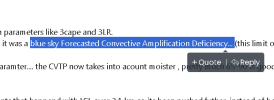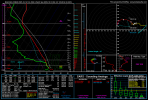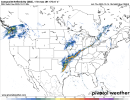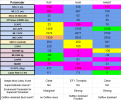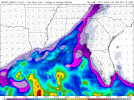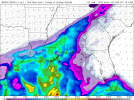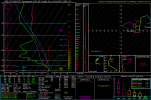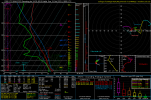happy joshoctober16th?!
but thanks for putting this together, even a liberal arts major like me can get some use out of this
misread that as (a liberal ant major).
anyhow i made CVTP because...
1:the original VTP has a major cap/limit issue with parameters like 3cape and 3LR.
this caused events that showd up as 40 VTP when it was a blue sky Forecasted Convective Amplification Deficiency... (this limit on 3cape and 3LR made this event go down to 12.3)
2:there is no moister in any tornado composite parameter. the CVTP now takes into account moister , pretty much 60-90% is good but when it gets lower or higher then that the CVTP number gets lower.
3: LCL has been changed , there were tornado events that happened with LCL over 2.1 km so its been pushed further, instead of being cap at 1 km now it caps at 0.7 km , however if it goes under 0.2 km (200 meters) it starts to lower the number as less then 200 meter events tend to be stratus rain mess.
4:ESRH is halved in power however i added in SRH3 to this composite parameter , they work together to and merged (divided by 2) , this was made to get rid of a super rare issue that could happen (only one tornado sufferd from this old problem and it was one of the F5 candidates on the Canadian papers)
it is to note CAPE / ESRH / SRH3 / RH are also all cap , however the CAPE and SRH take a very high number to get cap.
the other composite parameter DBRN , was made for 2 reasons.
1:without DBRN may 19 2019 tends to look like a superoutbreak event without it , and its just awkward to look at this event that has every other parameter looking perfect and a big Forecasted Convective Amplification Deficiency happens.
2:nudger theory video states if a storm is too inflow dominant the mesos will keep being sling shot away without anything ever happening or when its too outflow dominant it will tend to do a QLSC Forecasted Convective Amplification Deficiency event like may 19 2019.
while i know these inflow dominant Forecasted Convective Amplification Deficiency exist and i have watched them live , i sadly cant remember what events they were.
however there were data of the outflow events.
interesting note the Pilger event had the lowest number on the DBRN without having a Forecasted Convective Amplification Deficiency , being around 0.113.
however using a list of different parameter + the DBRN you can get the Pilger event being in a non outflow Forecasted Convective Amplification Deficiency
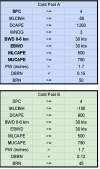
anyhow that's some of the info on these 2 parameters and why i made them.
this is a severe weather thread and i don't want this thread to overflow about only composite parameters.
however here is a link to a thread about composite parameters.
https://talkweather.com/threads/gen...rd-type-sars-and-other-parameters.2416/page-5

